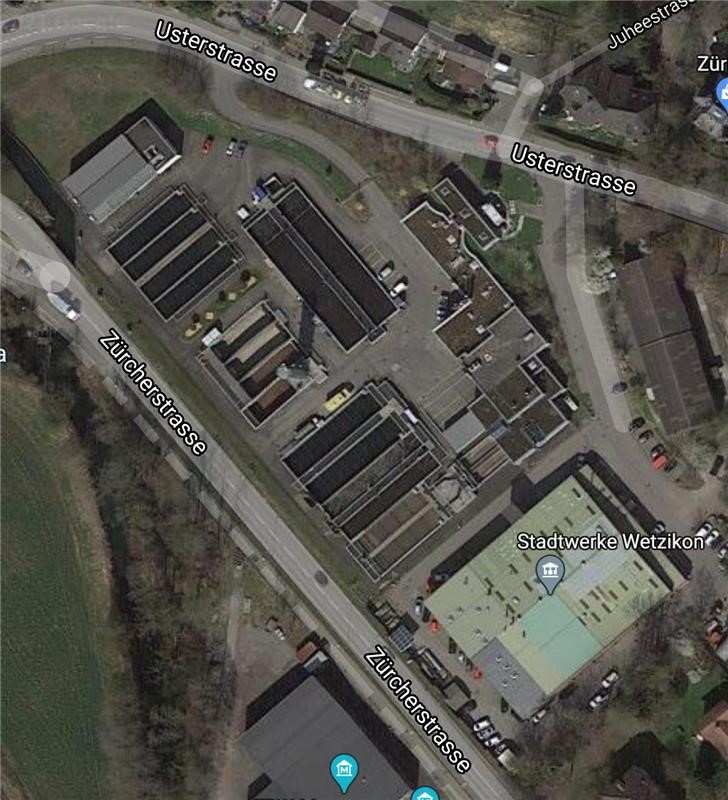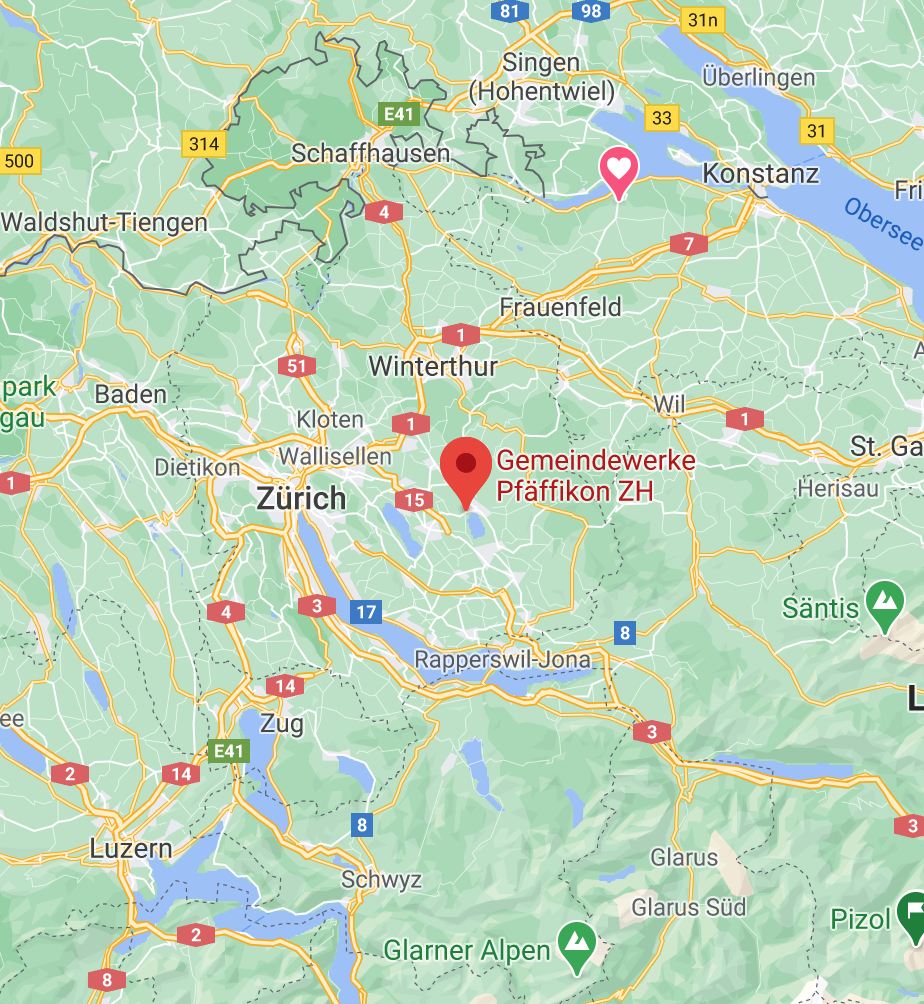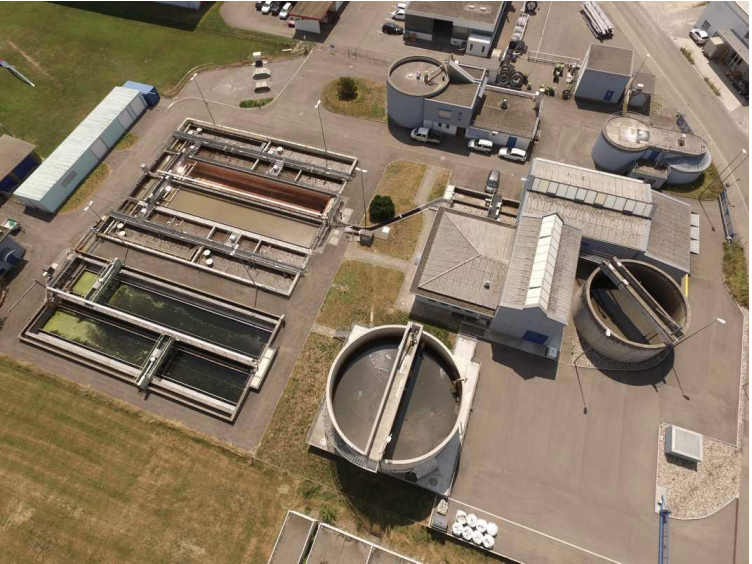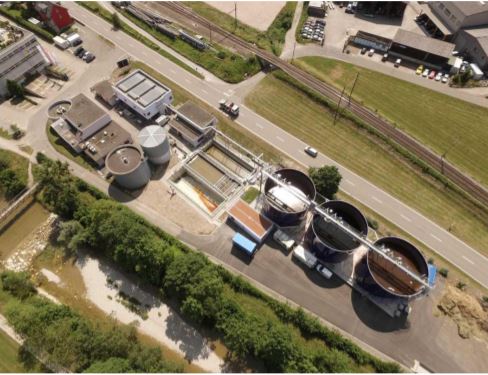The municipality of Rüti operates a wastewater treatment plant (WWTP) in Gruebensteg for about 14,500 inhabitants (approx. 16,750 population equivalents, including industry and commerce). The municipalities involved are Dürnten, with the village part Tann (2,650 PE) and Bubikon, area Kämmoos-Egelsee (350 PE).
In rainy weather, up to 250 l/sec of wastewater can be fed to the WWTP. Larger quantities are retained in stormwater tanks and later fed to the WWTP. After the 3-stage, i.e. mechanical-biological-chemical treatment, the wastewater is discharged into the Jona. Every year, about 11,500 m3 of digested sludge is dewatered and sent for incineration. The digester gas produced is processed in a combined heat and power plant and the electrical energy generated, approx. 250,000 kWh per year, is fed into the Rüti public utility grid. The waste heat is used to heat the digester rooms and the plant operation.
The WWTP was expanded between 1989 and 1994 and has been adapted to the new regulations to date. In the future, too, adjustments and renovations will be necessary on an ongoing basis due to new findings. Current planning goes up to 2020 and expects a load of up to 20,000 PE.
https://www.rueti.ch/topics/politik-verwaltung/verwaltung/abteilungen/klaranlage
For our personal water waste, is the ARA in Gossau responsible. It is located in the outskirt Gossau and covers the usage of ca. 15'000 people. The system started in 1971 and the last expansion was a new filter in 2012. The coordinates are 2699 058 / 1240 065.
The waters are the Greifensee, the Aabach and the Gossauerbach.

Fabrizio and Yanik
My personal WWTP is in Rüti ZH, right next to my old primary school. The ARA of my town is designed for 14'500 residents.

The wastewater from Wetzikon is treated in the Flos wastewater treatment plant, which was built in 1961. However, not only the water from Wetzikon, but also from Aathal/Seegräben, Auslikon (Pfäffikon) including the baths, Ober-Balm (Hittnau) and Grüt (Gossau).
It is located at the Flos collection point on Usterstrasse, just by the Aabach.
At that time it was designed for 22,000 population equivalents. Due to population growth, the Flos wastewater treatment plant was expanded at a cost of 43 million Swiss francs. The idea was not only to cope with the growing population but also to keep the plant at the latest technical level, which was achieved with the help of new filter systems. After the conversion, the plant treats 37,000 population equivalents.

The municipal wastewater treatment plant is working at an average capacity of 120 %. For this reason, preparatory work for an expansion of the plant has been underway for some time.
Link
ARA Flos [www.wetzikon.ch]
The ARA Wetzikon has reached its limit. 37'000 citizens are registred in this system and according to 2018 the ARA Wetzikon is working 120%. So the system is overloaded. The municipal is trying to figure out how to increase the performance. The system is able to keep up the work because of it's hard working employers and financial support of the commune. A petition is already set up to collect money for the upgrade of the ARA Wetzikon.

(Source of the Photo: Screenshot Google Maps)
Maplink: https://www.google.com/maps/place/Kl%C3%A4ranlage+Flos/@47.329379,8.7813368,15z/data=!4m5!3m4!1s0x0:0x936b3bf684920dd5!8m2!3d47.329379!4d8.7813368
Post by Kadir & Rico
WWTP; WasteWaterTreatmentPlant
The WWTP treatment plan is executed in 3 steps. Each of these steps is crucial for clean water.
Step I) is to get rid of fats or oils by using a "pre-treatment".
Step II) is responsible for biological treatment of organic particles in the waste water. In order to do so, the plant has to work through several technically hight maintenance processes.
Step III) During the biological process, a mixture of bacteria creates some sort of "dirt" (Schlamm). This dirt is being removed in a different pool of the plant.
The Waste Water Treatment Plant in Wolfhausen is about as big as 2/3 of a football field. Since there is another one in Bubikon which is the same district (Gemeinde), which means it covers an area of about 3500 people.


Kläranlage Schachen in Wolfhausen
I live in Hittnau. My personal waste water is cleaning The ARA Pfäffikon. The adress from the ARA Pfäffikon is Schanzweg 2, 8330 Pfäffikon (see the map below). They clean the waste water from Hittnau, Bäretswil, Fehraltorf and Pfäffikon.
Expansion size: 17 000 population equivalents


Link:
ARA Pfäffikon [gwpzh.ch]
My personal water is cleaned by the WWTP in Hinwil.

Here you can see, where the WWTP in Hinwil is located: map
The investment costs of the WWTP in Hinwil amount to CHF 16.8 Mio.
The last extensions of the WWTP took place from 2010 - 2014.
The expansion size [1] is 21000 population values [2].
The catchment areas [3] are Hinwil and partly Bäretswil.
Vocabulary:
[1] Ausbaugrösse
[2] Einwohnerwerte
[3] Einzugsgebiete
What WWTP is cleaning my personal waste water?
The wastewater treatment plant in Dürnten-Bubikon processes our wastewater.
Where is it located?
The WWTP is located at Weidlistrasse 8 in Bubikon.
What are the dimensions of the ARA or how many people is it designed for?
This WWTP deals with the municipalities of Dürnten, Bubikon and Hinwil and thus 8095 inhabitants (as of 2018). The ARA is developed for 8400 inhabitants.

ARA Dürnten-Bubikon
Sources
BubikonD.pdf (zh.ch)
Karishma
Bauma's wastewater treatment plant treats wastewater from the surrounding communities of Bauma, Fischenthal, Bäretswil, Hinwil, Hittnau, Wila and Wildberg.
Total connected inhabitants 7517
Bauma: 4547
Fischenthal: 2275
Bäretswil: 361
Hinwil: 12
Hittnau: 247
Wila: 52
Wildberg: 22
In the operating year 2019, a wastewater volume of 728,983m³ was treated. This is 157810 m³ more than the year
2018, which was very dry.
1969
The Bauma wastewater treatment plant (WWTP) was built in 1969 in Saland for a population of 6,000 and was renovated and expanded for the first time in the mid-1990s.
2035
The groundwater flow under the upper Töss supplies the Tösstal and Winterthur with first-class drinking water. In order to protect this from contamination in the long term, the Tösstal municipalities of Fischenthal, Bauma, Wila, Turbenthal, Zell, Weisslingen, together with the city of Winterthur and the AWEL have agreed to shut down the Bauma and Weisslingen wastewater treatment plants by 2035. The wastewater from the Tösstal valley would then be directed to the ARA Hard in Winterthur. It is planned to establish a joint institution under the name "Regional Wastewater Disposal Tösstal". In the referendum on 19 May, the foundation of the GA was clearly approved. The new institution is to be founded in 2020 and create the infrastructure for the upper Töss to be free of wastewater.

Picture: ARA Bauma (located in Saland)
Regards,
Alexa & Sandra (Bauma) & Chiara (Bäretswil)